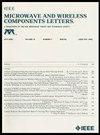一种多频阻抗匹配宽带功率放大器
IF 3.3
2区 工程技术
Q2 ENGINEERING, ELECTRICAL & ELECTRONIC
引用次数: 4
摘要
这封信提出了一种多频阻抗匹配宽带功率放大器(PA)的设计,它不同于传统的PA阻抗值随工作频率的变化而变化。该方法通过负载牵引系统选择晶体管器件的阻抗值。然后,使用由微带线级联组成的匹配网络将器件阻抗匹配到50 $\Omega $。对匹配网络进行了优化,以在多个频率下提供所需的阻抗传输特性。这种设计方法有效地降低了放大器在覆盖频率范围内的输出阻抗变化。PA整体结构简单,在保证性能的同时扩大了带宽。在此基础上,利用中国科学院微电子研究所自行研制的横向扩散金属氧化物半导体(LDMOS)晶体管,设计并制作了宽带放大器。测量结果表明,所设计的放大器在0.5 ~ 2.3 GHz范围内的饱和输出功率大于41 dBm。排水效率为43.62% ~ 55.38%。当平均输出功率为34.3 dBm时,相邻通道泄漏比(ACLR)也优于−31.58 dBc。本文章由计算机程序翻译,如有差异,请以英文原文为准。
A Broadband Power Amplifier With Multifrequency Impedance Matching
This letter proposes a multifrequency impedance matching broadband power amplifier (PA) design, which is different from the traditional PA impedance value changes with the change in the operating frequency. This method selects the impedance value of the transistor device through the load–pulling system. Then, matching networks composed of a cascade of microstrip lines are used to match the device impedance to 50 $\Omega $ . The matching networks are optimized to provide the desired impedance transfer characteristic at multiple frequencies. This design approach effectively reduces the amplifiers’ output impedance variation over the covered frequency range. The overall structure of the PA is simple, and the bandwidth is expanded while ensuring performance. Based on this method, a broadband PA was designed and fabricated using the self-developed laterally-diffused metal-oxide semiconductor (LDMOS) transistor of the Institute of Microelectronics of the Chinese Academy of Sciences. The measurement results show that the saturated output power of the designed PA in the range of 0.5–2.3 GHz is greater than 41 dBm. The drain efficiency is 43.62%–55.38%. When the average output power is 34.3 dBm, the adjacent channel leakage ratio (ACLR) is also better than −31.58 dBc.
求助全文
通过发布文献求助,成功后即可免费获取论文全文。
去求助
来源期刊

IEEE Microwave and Wireless Components Letters
工程技术-工程:电子与电气
自引率
13.30%
发文量
376
审稿时长
3.0 months
期刊介绍:
The IEEE Microwave and Wireless Components Letters (MWCL) publishes four-page papers (3 pages of text + up to 1 page of references) that focus on microwave theory, techniques and applications as they relate to components, devices, circuits, biological effects, and systems involving the generation, modulation, demodulation, control, transmission, and detection of microwave signals. This includes scientific, technical, medical and industrial activities. Microwave theory and techniques relates to electromagnetic waves in the frequency range of a few MHz and a THz; other spectral regions and wave types are included within the scope of the MWCL whenever basic microwave theory and techniques can yield useful results. Generally, this occurs in the theory of wave propagation in structures with dimensions comparable to a wavelength, and in the related techniques for analysis and design.
 求助内容:
求助内容: 应助结果提醒方式:
应助结果提醒方式:


